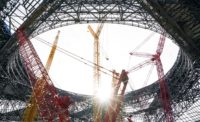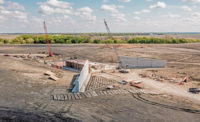Spanning the River
The new $14-million East ParkCenter Boulevard Bridge in Boise will provide a new access to East Boise and Barber Valley for pedestrians and motor vehicles.


Adam Zaragoza, Ada County Highway District project manager, says the bridge will allow easier access to recreation opportunities at Lucky Peak Reservoir and beyond. The four-lane bridge connects ParkCenter Boulevard and Warm Springs Avenue and includes sidewalks, bike lanes and greenbelt connections. McAlvain Group of Cos. of Boise was the general contractor on the project.
After more than three decades from conception to completion, the bridge opened on Sept. 29, two months earlier than planned. It should ease traffic on Warms Springs Avenue between downtown Boise and Harris Ranch, a 3,000-home subdivision with an expected built-out during the next 10 years.
“This bridge represents the culmination of a community vision for southeast Boise and the Barber Valley, a vital new transportation connection for decades to come,” says Carol McKee, president of the Ada County Highway District Commission.
Noise Issues
Zaragoza says the project had several interesting aspects. “We had to consider the noise created by the pile driving, local bald eagle and blue heron colonies and the delivery of the massive girders to the site,” he says.
The project consists of a 440-ft, two-span bridge over the Boise River; a 104-ft, single-span bridge across the walling ditch; and a 36-ft, single-span pedestrian bridge across Logger’s Creek.
“Pile driving is noisy, so during the school year, we coordinated with the principal of the local elementary school and (initially) put a restriction on the work from 4 p.m. to 8 p.m., limiting us to one or two a day,” Zaragoza says. “As it turned out, the school faculty said that the operation was far enough away that noise was not an issue. That worked out well because the neighborhood wanted it done quickly, so we got a waiver from the principal and worked nonstop during the day.”
CH2M Hill’s Boise office designed the main bridge over the river, and HDR Engineering Inc. of Boise designed the two smaller bridges. Kim Nokes, CH2M Hill project manager, says bald eagle and great blue heron monitoring was a part of the project, and that impacted construction timeframes.
Nokes says one of the project goals was to make the bridge’s aesthetics pleasing to the community—both pedestrian and wildlife. “We utilized a design concept called Context Sensitive Solutions, where you work within the context of your surroundings,” Nokes adds. “That meant we had to consider the trail system for the pedestrians and the habitat for wildlife.”
Urban and Rural
Located on the south side of the river is a development with stores, restaurants and offices. On the north side are wetlands and other undeveloped areas. The design process focused on blending these urban and natural environments.
Project Team
East ParkCenter River Crossing
Southeast Boise
$20.7 million
Owner: Ada County
General Contractor: McAlvain Group of Cos.
Design Firm: CH2M Hill, Sub consultant: HDR
Start: May 2008
Finish: Sept. 2009
Delivery of the massive girders provided the biggest logistical problem. Delivery took place in the middle of the night to avoid traffic-safety issues, so traffic restrictions were implemented from 4 to 7 a.m. on delivery days for the 24 144-ft-long bridge supports.
The girders are 9 ft tall and 32 in. wide and weigh approximately 73,000 lbs each. Once they arrived at the site, the massive beams had to be backed into position. “The girders are long because they will span the entire river without having to place a pier in the river itself,” Zaragoza says. “They are also long enough to accommodate the river overflow channel in the event of a 100-year flood.”
Boise Mayor David Bieter says of the project: “By providing easier access to the Barber Valley, the East ParkCenter bridge will encourage new residential and commercial development close to Boise’s employment center, helping our community avoid the negative environmental impacts caused by sprawl-type growth. This new bridge is a good example of how transportation and land-use planning can be integrated to promote both economic development and sustainable environmental practices.”







